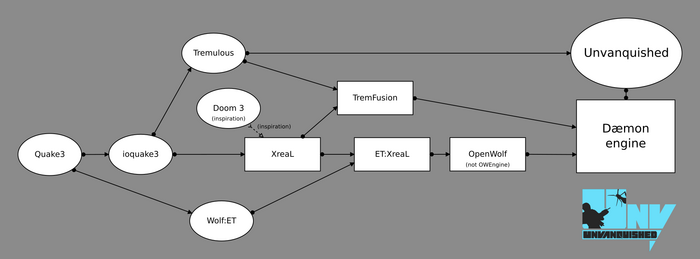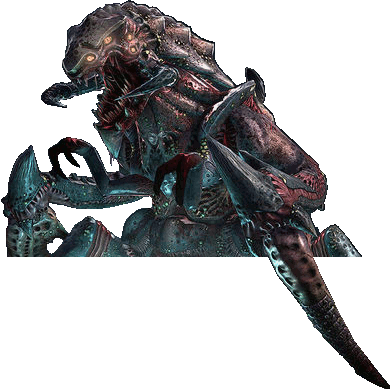Dæmon engine
Unvanquished development uses the Dæmon engine to power the Unvanquished game, an ever-improving engine with a long list of modern features (see below).
Contents
Engine history
Note
The Dæmon engine was named OpenWolf for a very short time in its very early days and must not be confused with another OpenWolf engine based on the Qio engine, that other OpenWolf engine isn't based on Dæmon (and Dæmon isn't based on it).
Dæmon can trace its lineage all the way back to Quake 3, integrating the various features and improvements from quite a few engines before it. The aim of Unvanquished Development is to make Dæmon the most modern and best available quake-derived FOSS engine.

Engine source code
The Dæmon engine source tree is tracked on a dedicated repository to make contributions easier and help projects to port their game on it:
- Dæmon engine repository: https://github.com/DaemonEngine/Daeon
See the Dæmon engine code page for details.
Engine features
Note
Of all features showcased by the Unvanquished game, some are implemented in the Dæmon engine, some are implemented in the game code, like bot navigation, translation or RmlUi user interface, etc. and others in the updater/launcher. As a game developer if you want to make your own game you may want to reuse the engine and fork the Unvanquished game to use it as an upstream and be able to merge back our game code improvements to your game.
Sandboxed cross-platform virtual machine
The game code is sandboxed and running in a virtual machine.
For the virtual machine we currently use the Native Client (NaCl) technology, and are in process to replace NaCl with WebAssembly (Wasm) as industry shifted from NaCl to Wasm.
The virtualized game code is cross-platform: build it once, deliver it to players running on Windows, Linux and macOS. Once the engine runs on a platform, the game code runs.
It makes very easy to modders to distribute their own game code to players on supported operating system, and it makes very easy to players to enjoy those mods since custom game code can be downloaded from servers while running it sandboxed.
Unlike the old Q3VM technology we're not limited to the old C version supported by the non-free LCC compiler, and we can use third-party C++ libraries in the game code, while running it with close-to-the-metal performance in a sandboxed virtual machine.
Rendering
- Modern OpenGL 3 renderer with very large hardware support,
see the GPU compatibility matrix; - Improved Quake 3 shader (material) system:
- Procedural vertex deformation;
- Alpha mapping;
- Specular mapping (color and intensity);
- Physically based shading (PBR);
- Normal mapping;
- Relief mapping;
- Glow mapping;
- Multitextured terrain blending;
- Many special effects:
- Motion blur;
- Rim lighting;
- Bloom;
- Heat haze;
- FXAA;
- Outline fonts;
- Procedural animation blending.
Extensible virtual file system
See the DPK and Filesystem pages.
Game data is distributed as a set of DPK packages, which are Zip archives storing files. Each file from each DPK packages is added to a virtual file system that is seen by the game. The game code is only allowed to explore that virtual file system (the game code is not allowed to explore the user's file system).
This is very similar to the idSoftware PK3 and PK4 VFS but we extended it to solve various design issues: unlike PK3 and PK4 a DPK can provide a list of dependencies to load, so the game engine only loads the required packages for the current game and for the map currently played on.
The dependency mechanism also allows a package to extend an older version of itself, either by adding files to the VFS, either by replacing files from older packages, making possible for a game project to deliver partial updates through light delta packages: with a suitable distribution system (see our updater/launcher), players would only download the delta paks containing the new files when a new release is distributed.
Networking
- Remote administration support;
- Custom
unv://protocol to allow starting the game from a web browser or with an internet link; - 🚧️ TODO: Mumble integration, what's the status of it?
Miscellaneous
- Curses-based console
Supported data formats
See Filesystem for instructions on how to package assets.
Image formats
See the Image page.
- CRN — optimized for GPU (like DDS), ✅️ Recommended;
- WebP — lossy and lossless, ✅️ Recommended for skyboxes as lossy, and lightmaps as lossless;
- DDS — Direct Draw Surface, optimized for GPU, Well tested;
- KTX — Khronos Texture, optimized for GPU, Poorly tested;
- PNG — lossless and slow, ⚠️ Discouraged;
- TGA — lossless but uncompressed, ⚠️ Discouraged;
- JPEG — lossy, ⚠️ Discouraged.
Material formats
See the Material page.
- Quake 3
.shadermaterials; - Dæmon
.shadermaterials — extension of Quake 3 materials with pre-collapsed stages and some features from Doom 3 and Xreal, including fixes for regressions from Doom 3 like multitextured multistage materials (like multitextured terrain blending); - DarkPlaces
.shadermaterials — extension of Quake 3 materials with custom keywords (not all of them are supported) and implicit sidecar texture loading.
Other formats like Particle and Trail formats are not implemented in engine but in Unvanquished game code.
Sound file formats
See the Audio page.
- Opus — lossy, ✅️ Recommended;
- OGG Vorbis — lossy, Well tested;
- Wav — lossless but uncompressed, ⚠️ Discouraged.
Model formats
See the Model, Modeling and Exporting models pages.
- IQM — bone-based, ✅️ Recommended;
- MD5 — bone-based, Well tested;
- MD3 — vertex-based, ⚠️ Discouraged.
Map formats
See the BSP and Mapping pages.
- Quake 3 / Wolf:ET style BSP (
IBSP46,IBSP47).
- Announcing Dæmon engine Beta 0.52 by illwieckz;
- Upgrading our 15-year-old engine by Kangz;
- Merge of the first batch of engine-upgrade changes by Kangz;
- Big changes to the Filesystem by Kangz;
- Moving the server-side gamelogic to PNaCl by Kangz.
Non-engine features
Game features
Note
Those features are not implemented in Dæmon engine but in Unvanquished game code.
As a game developer if you want to make a game on Dæmon engine, you'll may also want to fork Unvanquished and use it as upstream to benefit from these features as well.
Some of those features were previously living in the engine, but we moved them to the game code to make it easy to update them without releasing the engine, and to simplify the interactions between engine and game.
Localization
Localization is implemented in Unvanquished game code, it supports translation of C++ strings and RmlUI strings (starting with 0.53.0).
RmlUi user interface
See the UI page.
The Unvanquished user interface is implemented using RmlUi (libRocket before 0.53.0) supporting RML and RCSS formats based on HTML4 and CSS2 standards (it supports transforms!).
See the Navigation mesh and Behavior tree pages.
Unvanquished implements navigation mesh based bot AI configured with behavior trees.
Gameplay features
- Voice say system;
- Support for multiple build layouts per map.
Game formats
Particles and trails
See the Particle and Trail pages.
Unvanquished implements particle and trails, the formats are the ones of Tremulous.
Launcher and updater features
Note
Those features are not implemented in Dæmon engine but in Unvanquished launcher code.
As a game developer if you want to make a game on Dæmon engine, you'll may also want to fork our Launcher and use it as upstream to benefit from these features as well.
See the Launcher page.
Auto updates
Our auto update mechanism is implemented as a game launcher. This is the icon the player executes to run the game. The engine itself is just an updatable file among others.
The launcher checks for updates at startup. If there is an update, the update is downloaded and applied and the game is run. If there is no update, the game is run.
Peer-to-peer delta updates
The update is done using BitTorrent, enabling peer-to-peer download (reducing pressure on game infrastructure) and partial updates (see #Extensible virtual file system on how the Dæmon engine makes possible to ship updates as delta packages).
Configuration
The updater also does extra configuration steps like setting-up the unv:// protocol (see #Networking) to enable players to join games by clicking links on web pages.
Dæmon-based games
The Unvanquished game is currently the only released game running on the Dæmon engine.
Though, multiple projects are attempting to make games on or port games to the Dæmon engine.
See the Daemon based games page for more information.

